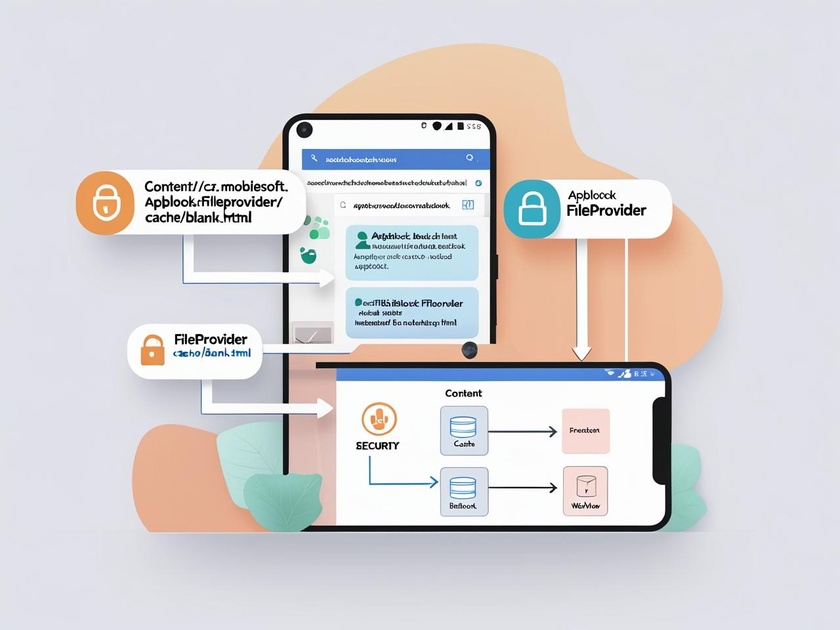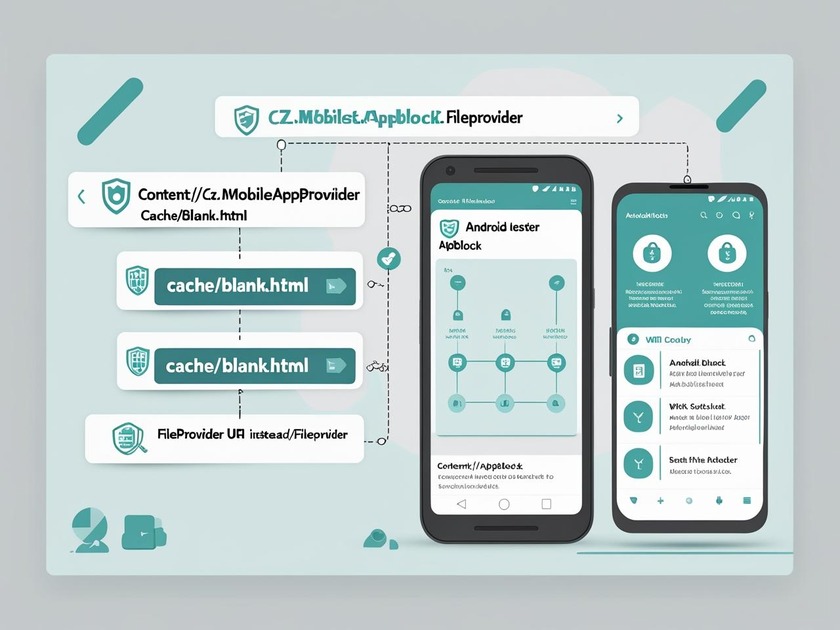What Is a Content URI in Android?
In Android, a Content URI—formatted like content://authority/path/...—serves as a secure pointer to data managed by an app’s internal provider. Instead of exposing raw file paths (e.g., /data/data/...), developers use Android’s FileProvider to generate such URIs. These URIs allow apps to share files (temporarily) with the system or other apps while keeping permissions tight and preventing unauthorized access
Specifically, content://cz.mobilesoft.appblock.fileprovider/… means:
-
content://→ you’re accessing via a content provider. -
cz.mobilesoft.appblock.fileprovider→ the unique authority defined by AppBlock. -
The path (e.g.,
/cache/blank.html) → points to a specific file in its internal storage.
You can also explore more helpful content on DemainMail to expand your understanding
Meet AppBlock: The Context Behind the URI
AppBlock, by MobileSoft, is a screen-time and productivity app that helps users block or restrict access to certain apps and websites based on schedules, location, or Wi‑Fi.

-
Over 5 million downloads on Google Play, with a 4.6★ rating Google Play.
-
Feature list: scheduled blocks, strict mode, parental controls, usage stats, and more.
In this context, when a user tries to visit a blocked website or use a blocked feature, AppBlock may redirect that request to a neutral placeholder—namely, blank.html. This way, users don’t see errors or broken screens—just a seamless blank page that maintains the UI flow.
Anatomy of content://cz.mobilesoft.appblock.fileprovider/cache/blank.html
-
Scheme:
content:// -
Authority:
cz.mobilesoft.appblock.fileprovider(the FileProvider set up in AppBlock’s manifest) -
Path:
/cache/blank.html– a small HTML file stored within AppBlock’s cache folder.-
It serves as a placeholder to override blocked content.
-

Why a “Blank HTML” File?
This tiny file is more clever than it sounds—it neatly addresses several needs:
-
Visual Neutrality: Instead of error screens or broken webviews, the user sees a clean, distraction-free page.
-
Prevent Scripts/Trackers: Blocking with a blank page avoids loading any trackers or autoplay elements.
-
Maintain App Stability: Ensures WebViews don’t crash or get stuck waiting for content that’s blocked.
Common Use Cases of This URI
🔒 1. Redirecting Blocked Content
When a user attempts to access a site that’s blocked, AppBlock intercepts the WebView request and redirects it to the blank page—no errors, just silence.
⚙️ 2. Preloading in WebViews
Some apps preload a default or blank HTML to initialize a WebView cleanly. AppBlock leverages blank.html to control content appearance while ensuring smooth loading.
🧾 3. Logging & Diagnostics
Even if nothing is displayed, AppBlock can log when a blank page is loaded to track blocking activity, without exposing users to actual web content.
Is It a Privacy or Security Concern?
Short answer? No, it’s safe. But here’s why:
-
Temporary & Local: Stored under
/cache/, cleaned up by Android or when the app resets. -
FileProvider-Controlled: Only AppBlock (or authorized components) can access it—not other apps—thanks to scoped access policies .
-
Safe-by-Design: No personal or confidential content is stored here—just a blank or ultra-simple HTML page.
Key Questions to Ask
| Concern | Does it apply? |
|---|---|
| Permanently stored? | ❌ No—it’s temporary cache |
| Readable by other apps? | ❌ No—protected via FileProvider |
| Part of a trojan/malware? | ❌ No—AppBlock is Google Play–verified |
| Loading harmful scripts? | ❌ No—blank.html is inert |
Behind the Scenes: Android’s FileProvider
Since Android 7.0, apps can’t freely expose file URIs. FileProvider solves this by generating content URIs to grant soft, temporary access via the Android Intent system.
Benefits:
-
Hides real file paths.
-
Enforces permission control.
-
Keeps apps sandboxed.
-
Enables secure file sharing when needed.
AppBlock’s implementation follows these best practices: defining a provider in its manifest, mapping /cache/, and granting WebView access to blank.html only.
For Android Devs: When to Use a Blank Cache File
If you’re writing an app that intercepts or modifies web content, consider this pattern:

-
Use Placeholder HTML: Store empty or minimal HTML in cache to replace blocked or internal pages.
-
Use FileProvider: Expose it securely via a content URI, not raw file path.
-
Follow Scoped Storage: Keep in cache, clear routinely.
Pro tip: Remember to declare <provider> with the correct authority (e.g., cz.mobilesoft.appblock.fileprovider) and grant read access when loading blank.html into WebViews.
What to Do if You See This URI in Logs/Errors
Seeing the URI in logcat or crash reports? Don’t panic—it’s normal.
Quick checklist:
-
✅ Was AppBlock downloaded from Google Play?
-
✅ Is the URI used only a few times (when you attempted to access blocked content)?
-
❌ No crashes or WebView exceptions?
-
✅ blank.html exists in cache?
If yes: It’s working as intended. No action needed.
If blank.html isn’t found: Could indicate a cache miss—try clearing AppBlock’s cache or reinstalling if functionality is impaired.
Should You Delete blank.html?
Not manually. Android handles this:
-
Automatically cleans
/cache/under storage pressure, app reboots, or manual cache clears. -
Users can manually clear AppBlock’s cache, which removes blank.html.
No need for deeper file exploration or root access.
Privacy & Security Best Practices (User-Focused)
Even though blank.html is harmless, here are general hygiene tips:
-
✅ Install apps only from official sources (Google Play).
-
✅ Regularly clear app caches to free up space.
-
✅ Review app permissions, especially for storage, accessibility, or overlay.
-
✅ Keep Google Play Protect enabled.
-
🛡️ Use general security software if you suspect rogue behavior.
If you see unusual content URIs from unknown apps, treat it as a red flag—but this one isn’t.
Why This URI Matters
Though subtle, it sheds light on critical Android behaviors:
-
Use of content URIs for secure data abstraction.
-
The role of FileProvider in enforcing modern storage policies.
-
Real-world value of tiny UX touches—like blank.html—to avoid app-breaks or jarring UIs.
-
Insight into thoughtful design: placeholder pages, data hygiene, and privacy-first architecture.
FAQ: Quick Answers at a Glance
Q: Is the URI dangerous?
A: No. It’s a blank HTML file used securely via Android’s FileProvider.
Q: Can other apps read this file?
A: No—it’s locked behind AppBlock’s FileProvider permissions.
Q: Should I delete it manually?
A: No. Android or AppBlock manages it automatically; manual clearing via app settings is enough.
Q: Can this URI appear in other apps?
A: Only if other apps use similar content URIs with their own FileProviders (e.g., myapp.fileprovider/cache/foo.html).
Q: As a developer, how can I implement this?
-
Store placeholder HTML in cache.
-
Define FileProvider in
AndroidManifest.xml. -
Use content:// URIs to load in WebViews.
-
Set
<grantUriPermissions>and useFLAG_GRANT_READ_URI_PERMISSION. -
Clean cache periodically for privacy and storage efficiency.
Wrapping Up
content://cz.mobilesoft.appblock.fileprovider/cache/blank.html may look technical, but it’s a smart, benign part of Android’s content control system. It reflects:
-
Android’s secure file-sharing model via
FileProvider. -
User-friendly design ensuring blocked content doesn’t break apps.
-
Privacy-aware behavior: no tracking, no leakage, no user harm.
So next time you see this URI in logs or analyses, remember: it’s not a virus—it’s a silent safeguard, working behind the scenes to keep your productivity app efficient, secure, and stable.
Got questions about Android URIs, WebView placeholder pages, or FileProvider setups? Just ask!

